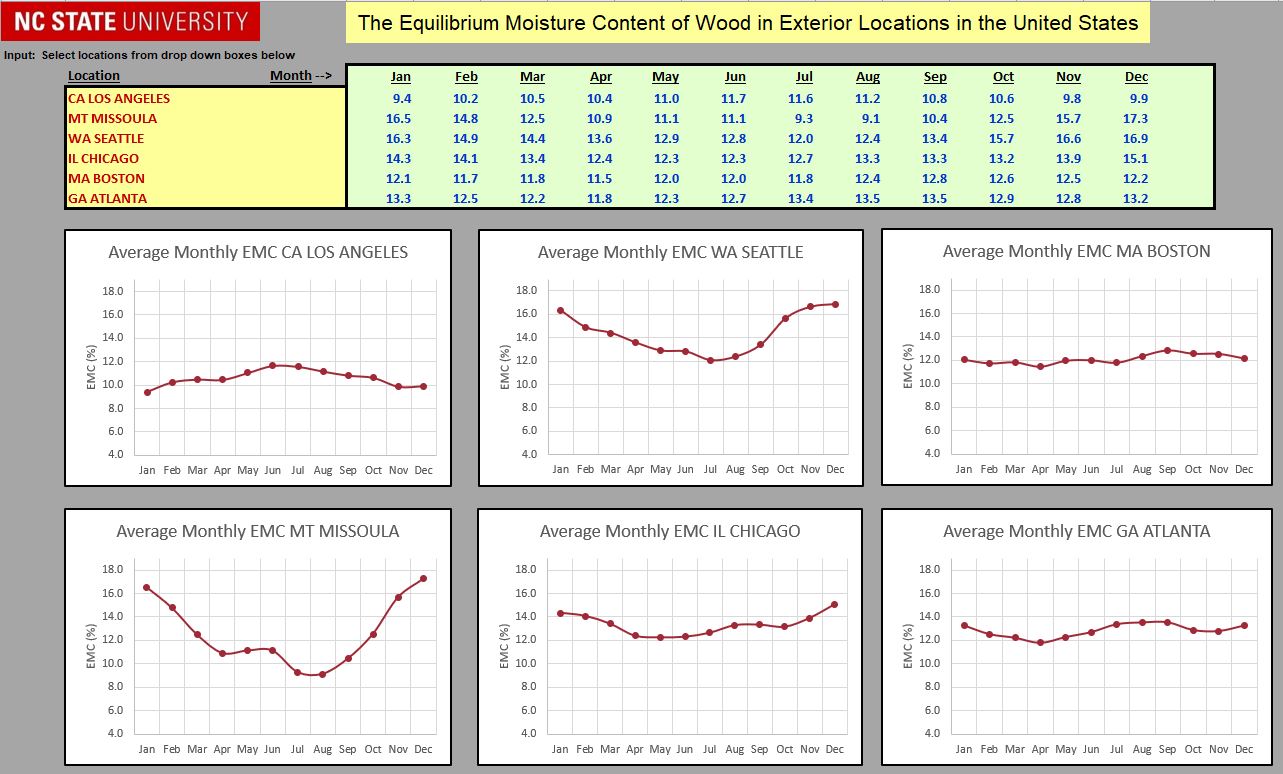Why Good Decks Go Bad - Part 2 - Lack of Acclimation
By
Steve Getsiv,
09/05/23
Kiln Dried vs Air Dried vs Green
The Importance of Acclimation to the Micro Climate
Natural wood products are a great choice for exterior decking. And when you're considering using a naturally durable hardwood such as Ipe, Batu, Red Balau, Bangkirai, Yellow Balau, or Torem, understanding the importance of humidity, moisture content, and acclimation are critical to the success of your project.
What is Moisture Content?
Humidity and temperature combine to create an equilibrium moisture content in wood products. Moisture content itself is defined as the "weight of water divided by the weight of the 100% dry wood that remains after all water (moisture) has been removed".
As shown in our last article, we can use an EMC table to look up the exact MC that the wood will eventually settle at. We found a really great tool from NC State to graph out the average EMC over the seasons. NC State EMC article and spreadsheet.

As wood dries, it shrinks by as much as 8% to 10% in thickness and width - that's all the way from "green" to "oven dry" - these are the terms we use in the lumber industry. "Green" basically means cut from the log, right out of the sawmill, with no time drying out. "Green" material is usually placed on sticks at the mill so it begins to dry out before further processing in a dry kiln or run through a planer to produce "green S4S E4E" lumber - think Douglas Fir Green Standard & Better Dimension used in housing construction. The wood itself doesn't start shrinking until it loses all its "free moisture" and dries below the "fiber saturation" point. Once the wood is below fiber saturation (around 25% moisture content), it begins to shrink linearly as the wood dries down until all the moisture is gone. Practically speaking, the minimum moisture content we ever see is around 3 to 4%. The technical lumber industry term is "drier than a popcorn fart" - that one is courtesy of Trevor Park of Finmac Lumber talking about his Winnipeg, MB Canada warehouse during Winter. Trevor was a steady customer of mine who passed away in 2019 after a long career in the lumber industry.

As discussed in our last article, we should expect about 1/4" of total shrinkage in width on a nominal 6" decking board. The reason we want to acclimate the board to the local climate is to minimize the amount of movement after installation. "Acclimating" doesn't necessarily mean "drying" - storing your deck boards in your "dry as a popcorn fart", heated garage all Winter long will certainly lead to swelling after installation. Those 1/4" gaps we recommend may not be enough to prevent the material from closing up and buckling.
It should be painfully obvious now why it so critically important to acclimate the material before installation. Deck installation is normally done during the dry part of the year, and therefore the wood is only going to swell, not shrink. But if you install green or air dried wood that has not had adequate time to acclimate to the local climate, then you're going to get shrinkage as the material continues to dry out after installation. We recommend a full 3 weeks of acclimation, outside in the elements, under a tarp or weather protected.
If you live in a wet part of the country (Portland, Oregon is a good example), by March or April, everything outside is absolutely water-logged! Your deck boards have taken on as much moisture as possible – and they've full swelled back up with gaps down to just about nothing. By June, it's dry again and those boards will have shrunk back to their initial size.
Key Points for Successful Acclimation
1. Acclimate for a minimum of 3 weeks prior to installation.
2. Don't acclimate in a dry heated space like you would for interior flooring.
3. Do acclimate out in the weather but keep it weather protected.
4. Put separator sticks in between layers of lumber - and keep some separation in width to allow for air flow.
5. Take more time to acclimate if you are starting with green or air dried material.
6. Optional - Use an accurate moisture meter to verify your deck boards are fully acclimated.
Proper acclimation is a critical step in the installation process. When wood is suddenly exposed to much drier or wetter conditions, it can move quickly, creating all kinds of problems including warping, cupping, twisting, cracking and splitting. Here at Nova, our goal is to be the best technical resource available when it comes to using hardwood for decking, siding, interior uses, industrial uses, and more.
By
Steve Getsiv,
09/05/23
Comments?
Display Name:
Contact Email:
please be respectful of others' opinions and do not use profanity.
comments may be edited for objectionable content.
Email addresses are not publicly posted, and are used to follow up directly with your comment as needed.




























